KPH30i
back to Koss
back to measurements
home
published: Dec-05-2021, updated: Dec-13-21
NO SMOOTHING is applied to the shown plots. Most measurement sites have some smoothing applied which ‘irons flat’ sharp peaks and ‘wiggles’. I do not use smoothing because some info about sound quality is lost when plots are smoothed.
Aside from a small correction of the microphone itself also some correction in the lowest frequencies is applied to the plots to compensate for the perceived loss of bass when using headphones. This is described HERE in more detail.
A ‘horizontal‘ frequency response curve on the shown frequency response plots on this website thus indicates a perceived ‘flat’ tonal signature.
ALL measurements are made with a good SEAL on a flatbed measurement rig.
The shape of your head, bone structure, pad size, pad ‘softness, (compliance), hair or no hair and or wearing glasses may (drastically) change the frequency response of some headphones, so… your personal experience may differ substantially from these plots.
Frequency response (tonal balance) is the most sound-determining aspect of headphones. A horizontal line shows audible neutral response in the plots on this website. Deviations in different severities at different frequency bands have an effect on the sound character.
The bigger the deviation the stronger the effect.
Below an aid to help determining the sound character of headphones with relation to the frequency response.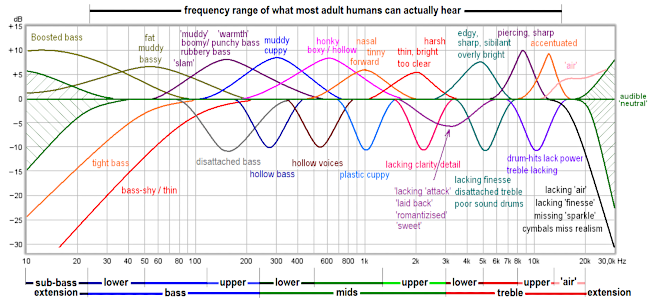
Koss KPH30i
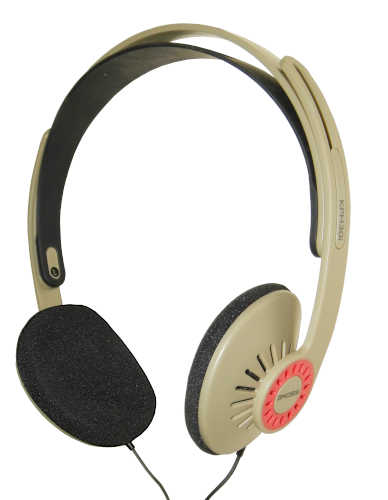
The Koss KPH30i is an open on-ear headphone. The MSRP hasn’t changed since 2017 and still is $ 30.-
In the mean time it also comes in less ‘retro’ looks. It is available in white with blue accents, dark grey and a transparent one as well.
The reviewed one is made from a beige-grey plastic and has a light red and blue ring on it indicating right and left.
This is a very lightweight headphone (weighs only 65 gram) and has a very low clamping force (2N) but because of its light weight it stays on the ears while not clamping hard on the ears.
This makes it comfortable to wear for an on-ear. Despite the low clamping force my ears still started to hurt when wearing glasses.
The headband can extend 30mm (sliders) and can be pulled apart quite a distance (200mm). The part that sits on your head is a grey silicone strip, very similar to the older and similar priced KTX-PRO1.
The KTX-PRO1 has a light blue silicone headrest and feels more solidly built.
I have seen pictures on the web of snapped headbands on the KPH30i. This may well be covered by Koss’s limited lifetime warranty (shipping at customers expense) It’s light weight and thin pieces of plastic on it don’t inspire confidence this headphone is sturdy and can take a beating. Handle with care.
The pads are foam which can be replaced. I have had to replace foam pads on my KSC35 and KSC75 a few times already even when not using them much. I expect these pads to degrade at about the same rate. When, one day, it sounds like a driver is broken check the foam pads first. A rogue hair may well be stuck in it and poke against the driver. This is an easy fix.
The cups only have a very limited swivel. Because of this, depending on how wide your head is and how far you have to extend the headband, the pads may or may not rest against your pinna evenly.
With a sensitivity of 117dB/V (efficiency = 105dB/mW) and medium impedance (57 Ω measured) this headphone plays quite loud directly from a phone.
Then there is the non-replaceable cable. It is horribly thin and feels very fragile. It has a silicone sheathing and just under the chin there is a microphone + remote button for taking calls acc. to CTIA standard so intended for apple devices (the ‘i‘ in KPH30i probably indicates this). The 1.2m cable tangles like crazy.
All in all this headphone is and feels flimsy but at the same time is very lightweight and comfortable for an on-ear. This is clearly made for on the go but of questionable quality when one likes to stuff their headphones in a bag when not using them. It does not collapse into the headband or fold flat for easier transport.
This reviewed (used) Koss KPH 30i is for sale
specifications:
Type: on ear (supra-aural), open
Usage: home, portable
Driver type: dynamic
Pads: replaceable foam
Collapsible: no
Headphone cup connector: fixed
Cable entry: dual sided.
Cable: 1.2m with mic/remote in a 3.5mm TRRS jack (CTIA = suited for apple)
Outer Pad dimensions: thickness = 4mm, height = 65mm, width = 50mm, pinna shaped.
Driver size: 30mm
Nom. power rating: 30 mW (estimated)
Max. voltage: 1.3Vrms (4Vpp)
Max. current: 22mA
Max. S.P.L.: 119 dB
Impedance: 57 Ω (measured)
Efficiency: 105dB @ 1mW
Sensitivity: 117dB @ 1V
Weight: 65 g. (without cable)
Clamping force: very low (2N)
Accessories: none
Subjective sound description:
Low bass is not present but bass itself is present. The mids have a warmth to it and not very dynamic sounding but somewhat muffled. Treble quality is nothing to write home about and not accentuated but a bit coarse and lacking ‘air’.
Overall the sound is easy to adjust to, just like that of the KSC75 and PortaPro and does not have objectionable qualities. Those looking for detailed Hi-Fi sound quality should look elsewhere.
Note: How this headphone sounds (tonal character) is dependent on the fit and seal of the headphone. The description above and measurements below are made with a good seal.
Measurements:
Below the frequency response of the KPH30i (Left, Right)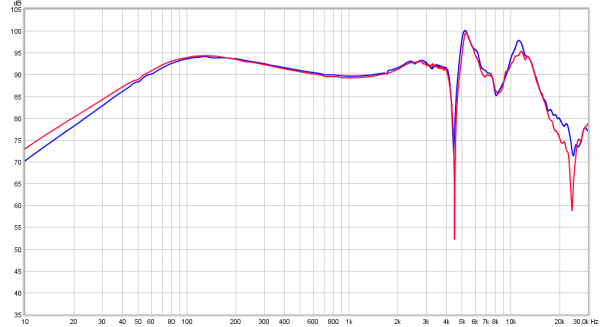 The channel matching is very good. Mid bass is elevated about 4dB and responsible for the warm sound signature. Bass rolls off below 60Hz. Up to 2kHz the response, just like that of the comparable Koss headphones, is free of wiggles dips. Above 3kHz the response gets jagged and shows a lot of dB in variations and drops off above 15kHz. Because of this treble quality is not great but fortunately not objectionable either. This headphone is easy to adjust to and sounds believable pretty quickly until one directly compares it to more proficient headphones.
The channel matching is very good. Mid bass is elevated about 4dB and responsible for the warm sound signature. Bass rolls off below 60Hz. Up to 2kHz the response, just like that of the comparable Koss headphones, is free of wiggles dips. Above 3kHz the response gets jagged and shows a lot of dB in variations and drops off above 15kHz. Because of this treble quality is not great but fortunately not objectionable either. This headphone is easy to adjust to and sounds believable pretty quickly until one directly compares it to more proficient headphones.
compared to
Below the KPH30i versus the PortaPro (the about 15 year older version)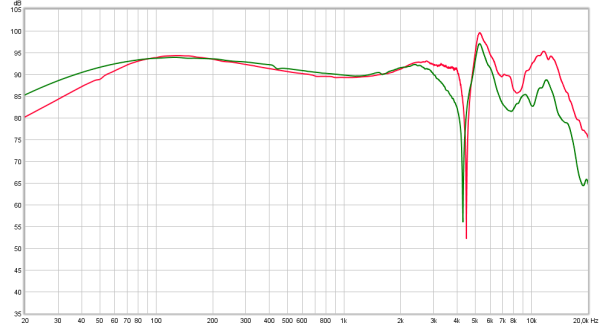 The PortaPro had better bass extension, a similar ‘issue’ at 4.5kHz and a bit more clarity and treble.
The PortaPro had better bass extension, a similar ‘issue’ at 4.5kHz and a bit more clarity and treble.
Below the KPH30i versus the PortaPro (about 5 year old version)
Bass extension is very similar, mids is very similar, in fact everything is very similar. There is slightly more treble in the PortaPro. This may be because the PortaPro does not rest against the ear but rather on pads above the ears so exerting less pressure on the pinnae.
Below the KPH30i versus the also about 10 year older ear-clip model KSC75 There is an undeniable family resemblance below 2kHz. Above 2kHz things become different.
There is an undeniable family resemblance below 2kHz. Above 2kHz things become different.
The KSC75 is less ‘muffled’ sounding and also treble quality is a bit better.
The newer KSC75 models, for some reason, have less bass extension.
Below the KPH30i versus the Drop ear-clip model KSC75x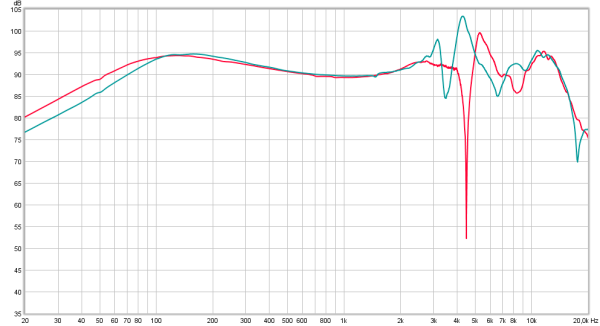
The Drop KSC75xmeasures and sounds closer to the current KSC75. Bass extension is slightly less (but not audible so). There is more clarity in the KSC75x but with some sharpness on some songs.
Below the KPH30i versus the ear-clip model KSC35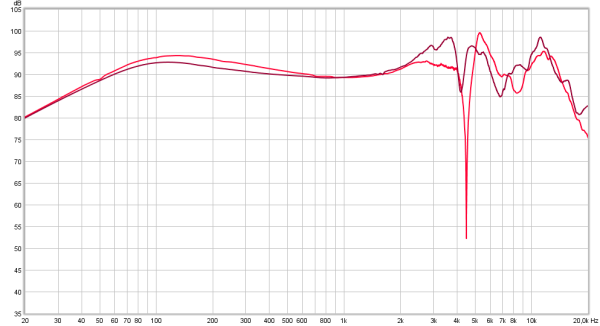 The tonal balance of the KSC35 is slightly more neutral (less mid-bass/warmth) and has more clarity (3kHz region) and slightly better treble quality.
The tonal balance of the KSC35 is slightly more neutral (less mid-bass/warmth) and has more clarity (3kHz region) and slightly better treble quality.
phase response
Below the phase response of the KPH30i (Left, Right)
Slow phase shifts are not very audible. Sharp changes in a narrow frequency bands may well be audible. The sharp rises at 4.5kHz and above may well be audible and also responsible for the perceived lesser sound quality of the treble.
output resistance / damping-factor
As this is a dynamic headphone the frequency response can be amplifier output resistance dependent when certain higher output resistance amplifiers are used.
Instead of showing impedance plots, which are hard to ‘read’ when it comes to assessing the tonal balance change in the real world, the KPH30i is measured via a few different resistance outputs (0.2Ω, 10Ω, 32 and 120Ω). On a higher output resistance amplifier the output level will be lower of course due to voltage division. To compensate for this the amplifier is cranked up to the same level (10dB for 120Ω at 1kHz in this case). This way the plots are overlaid and it is easier to see how the tonal balance changes. Output resistances between the mentioned resistance values will result in tonal changes between those traces.
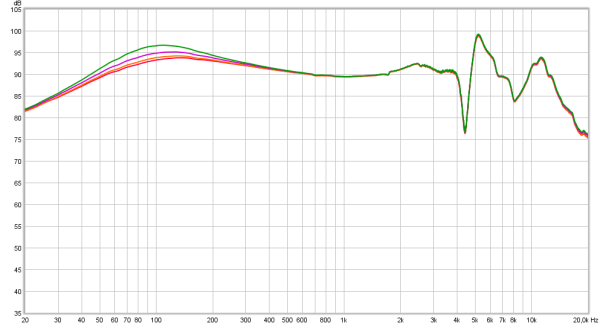
The tonal balance in the bass changes a bit when a higher output resistance amplifier is used. There is no reason to worry about using the KPH30i on devices with an output resistance up to 33Ω.
Linearity
The headphone is measured 4 times. Once at70dB, 80dB, 90dB and 95dB SPL. When the traces are the same shape then there is no compression which, sadly, is not the case here.
This will be more clearly visible when overlaid and amplified in vertical scale (2dB/div) in the plot below. 70dB, 80dB, 90dB and 95dB
Above 90dB SPL there is some slight compression. This means at higher listening levels and when using some EQ to compensate for the lack of bass extension the bass quality will go down. At ‘normal’ listening levels this does not happen yet. (Note the dB scale is 2dB/div)
seal
Seal can be an issue with closed-back headphones. Much less so with open headphone and even less with foam on-ears as the foam already (intentionally) leaks some lows to achieve a proper bass response. As not all pinnae (outer ear) is shaped similarly the foam pads may not touch every part of the pinna and leak somewhat.
Perfect seal, pads slightly lifted so small ‘leakage’ , Pads lifted even more.
How well the pads rest on the ears definitely influences the bass response/warmth. This means that for some people the KPH30i can sound a bit warmer/fuller/muffled than for others depending on how well the foam makes contact with the outer ear surface.
Below the distortion measurements of the KPH30i (Right channel). The measurements are made at 90dB SPL.
The measurements are made at 90dB SPL.
The plot above shows the level differences between the signal (upper trace) and the harmonics.
Most people prefer to see percentages instead of level differences so below the exact same plot except ‘normalized’ to the actual signal and level differences given in percentages.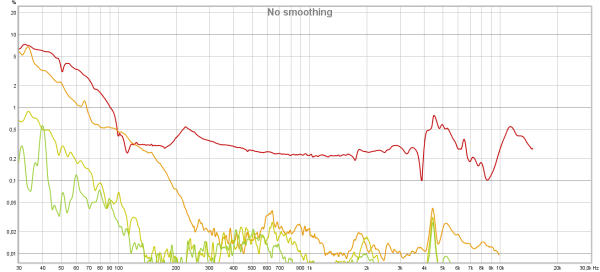 Distortion levels at 90dB SPL Below 100Hz are, not unexpectedly, on the higher side. This is partly because of the bass roll-off. Below 100Hz there is quite some 3rd harmonic distortion indicating that it is on the verge of compression. 2nd harmonic distortion below 100Hz is also elevated at these levels.
Distortion levels at 90dB SPL Below 100Hz are, not unexpectedly, on the higher side. This is partly because of the bass roll-off. Below 100Hz there is quite some 3rd harmonic distortion indicating that it is on the verge of compression. 2nd harmonic distortion below 100Hz is also elevated at these levels.
Above 100Hz distortion is quite good (except for the 4-6kHz problem area).
The actual 2nd harmonic distortion above 1kHz may well be lower than 0.2% . A shortcoming of my measurement rig.
Below the CSD (waterfall) plot of the KPH30i. (Left and Right are overlaid) The problem area around 5kHz is clearly a resonance. What’s interesting is that the sharp dip seen at 4.5kHz in the frequency response plot is hiding behind the resonance and thus not as deep as the frequency plot suggests. This is also seen in the group delay plot below where the 4.5kHz dip is clearly delayed in time.
The problem area around 5kHz is clearly a resonance. What’s interesting is that the sharp dip seen at 4.5kHz in the frequency response plot is hiding behind the resonance and thus not as deep as the frequency plot suggests. This is also seen in the group delay plot below where the 4.5kHz dip is clearly delayed in time.
Below the Group Delay plot for the KPH30i (Left, Right)
Only around 4.5kHz there are some group delay issues but very narrow. The frequency response unevenness is more audible than the delay at 4.5kHz.
A different plot is the spectrum plot. This basically is a CSD (Waterfall) plot but viewed from above where the level differences are colour coded instead of being in the vertical axis. Also the frequency range of the spectrum plot is wider (from 100Hz instead of 500Hz). The time span is also bigger in the spectrum plots and expired time is shown from below to top where in the CSD the time is shown from rear to front.
Below the spectrum plot of the KPH30i (Left channel) Bass is well damped and quickly decays. At around 1.8kHz there is a resonance but at a low SPL level only and very narrow (it can also be seen in the CSD).
Bass is well damped and quickly decays. At around 1.8kHz there is a resonance but at a low SPL level only and very narrow (it can also be seen in the CSD).
Step response
Below the step response plot which, when the sound is balanced and well extended should show a fast rise to around 0dB, (indicating fast driver response) and then should be slightly sloping downwards indicating bass extension. (Left, Right) Impulse response is correct but bass extension is clearly lacking. The membrane does like to vibrate quite long after an impulse.
Impulse response is correct but bass extension is clearly lacking. The membrane does like to vibrate quite long after an impulse.
square-wave and impulse response
Below 40Hz and 440Hz square-waves and 100μs impulse response, stimulus (and target) and measured response.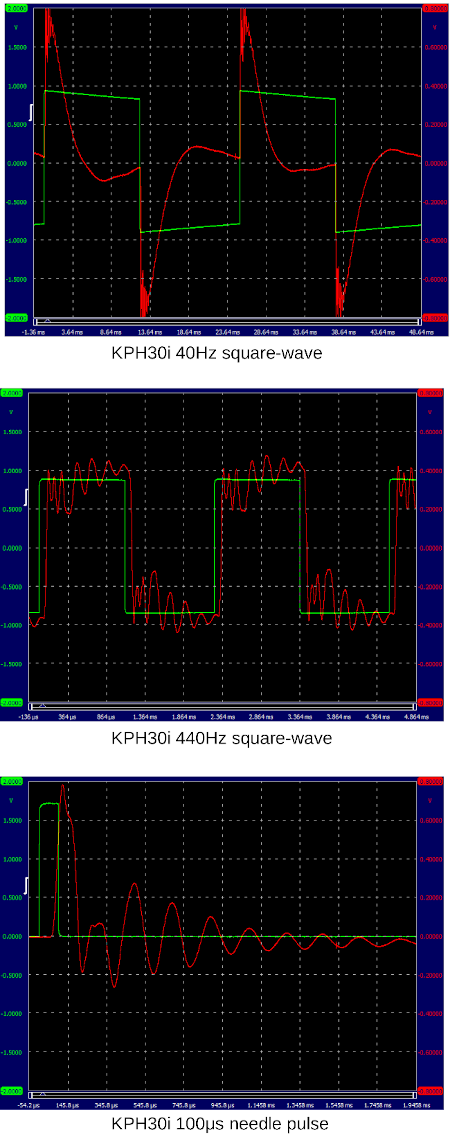 The 440Hz shows a pretty accurate square-wave with lots of ringing in it.
The 440Hz shows a pretty accurate square-wave with lots of ringing in it.
The ringing is also clearly visible in the impulse response. Once ‘triggered’ the driver membrane loves to resonate at 5kHz.
replacement Grado G-Cushion
This headphone came with (cheap imitation) Grado C-Cushions. They have to be slightly modified (using a knife) to ensure the headphone cable can run normally. This seems to be a popular modification. It does look a bit silly and out of scale. it turns the on-ear KPH30i into an over-ear and still partly on-ear headphone. The pads are a bit sloppy on there. They basically move the driver further away from the ear. Clamping force is distributed over a wider contact area so it feels even lighter on the head.
It does look a bit silly and out of scale. it turns the on-ear KPH30i into an over-ear and still partly on-ear headphone. The pads are a bit sloppy on there. They basically move the driver further away from the ear. Clamping force is distributed over a wider contact area so it feels even lighter on the head.
Of course this also has sonic consequences. The plot below shows what happens when the Grado G-cushions are used.  The efficiency drops 10dB from 105dB/mW to 95dB/mW which means you will have to dial up the volume to reach the same volume. The sensitivity drops from 117dB/V to 107dB/V which is just a few dB more sensitive than the HD650.
The efficiency drops 10dB from 105dB/mW to 95dB/mW which means you will have to dial up the volume to reach the same volume. The sensitivity drops from 117dB/V to 107dB/V which is just a few dB more sensitive than the HD650.
Another aspect that changes is the frequency response (tonal balance).
This is more obvious when the frequency response is plotted. Everything above 3kHz is boosted but becomes a bit less ‘ragged’. This means the KPH30i with G-Cushions sounds a lot clearer and brighter. A bit too bright though as the treble is now elevated by 10dB. Instead of being a bit muffled sounding it now sounds very clear and bright.
Everything above 3kHz is boosted but becomes a bit less ‘ragged’. This means the KPH30i with G-Cushions sounds a lot clearer and brighter. A bit too bright though as the treble is now elevated by 10dB. Instead of being a bit muffled sounding it now sounds very clear and bright.
The headphone does not sound muffled any more and is a bit more dynamic sounding.
Another thing that is visible is the wobblier response below 100Hz. This is also seen in the group delay plot below. Because of the varying thickness of the pad it absorbs and releases lower frequencies differently.
Another aspect that changes is distortion because efficiency has dropped we also need a higher voltage so distortion increases as well and directly from a phone the max. achievable SPL is also lower so bass will start to distort sooner.
The elevated treble can be lowered with some EQ to make it sound less bright but the other aspects (comfort, efficiency, distortion increase at higher volume) do not change.
Whether or not this is worth it to an owner is for them to decide. The pads can be bought for around $10-15 at shops like Ali-Express.
conclusion
The Koss KPH30i is an affordable and decent sounding headphone. It comes in a few different color schemes. It is very lightweight, has a low clamping force which makes it comfortable to wear (for an on-ear).
This headphone is intended to be used with Apple i-devices and may not work well from Android devices. Its high efficiency means it can play pretty loud directly from a phone.
There is no bass extension but bass itself is present but not overdone. Mids sound warm but a bit muffled and not very dynamic. Treble is not Hi-Fi quality and a bit coarse and lacks ‘air’ but at the same time does not sound poor either. It is very easy to get accustomed to its sound and sounds better than most similar priced headphones.
Not as good as the KSC75 ear clip headphones.
The mechanical construction feels cheap and appears to break easily when abused a bit.
The cable is very thin, tangles easy and might not have a long life. The remote/mic function is compatible with Apple products only.
The foam pads will need replacing after some time.
The KPH30i does not fold flat nor collapse into the headband nor is there a carrying pouch. This means that it takes up some space and might break when thrown in a bag when not using it.
